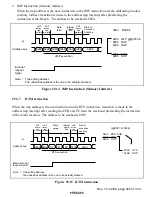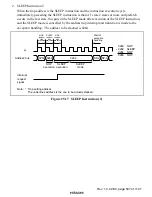
Rev. 1.0, 02/00, page 535 of 1141
25.3
Precautions in Usage
Address trap interrupt arises 2 states after prefetching the trap address. Trap interrupt may occur
after the trap instruction has been executed, depending on a combination of instructions
immediately preceding the setting up of the address trap.
If the instruction to trap immediately follows the branch instruction or the conditional branch
instruction, operation may differ, depending on whether the condition was satisfied or not, or the
address to be stacked may be located at the branch. Figures 25.2 to 25.22 show specific
operations.
For information as to where the next instruction prefetch occurs during the execution cycle of the
instruction, see appendix A.5 of this manual or section 2.7 Bus State during Execution of
Instruction of the H8S/2600 and H8S/2000 Series Programming Manual. (R:W NEXT is the next
instruction prefetch.)
25.3.1
Basic Operations
After terminating the execution of the instruction being executed in the second state from the trap
address prefetch, the address trap interrupt exception handling is started.
1. Figure 25.2 shows the operation when the instruction immediately preceding the trap address
is that of 3 states or more of the execution cycle and the next instruction prefetch occurs in the
state before the last 2 states. The address to be stacked is 0260.
φ
Address bus
Interrupt
request
signal
MOV
execution
MOV
instruc-
tion
pre-fetch
NOP
instruc-
tion
pre-fetch
Internal
opera-
tion
Data
read
Start of exception
handling
Immediately
preceding
Instruction
Address
025E MOV.B @ER3+,R2L
0260 NOP
(ER3 = H'0000)
0262 NOP
0264 NOP
025E
0260
0000
0262
*
→
* Trap setting address
The underlines address is the
one to be actually stacked.
Note:
In the figure above, the NOP instruction is used as the typical example of instruction with
execution cycle of 1 state. Other instructions with the execution cycle of 1 state also apply
(Ex. MOV.B, Rs, Rd).
Figure 25.2 Basic Operations (1)















































